
|
|
September 16, 2011
Mount San Bruno, Daly City/San Francisco, CA
One of our favorite radio towns is, alas, one we don't get to as often as we'd like - San Francisco and the Bay Area. So when a family event drew us westward in January 2010, we jumped at the chance to add a couple of days to the agenda to do some catching up on sites (and radio friends) we'd been meaning to visit.
Among
the treats this time around was an opportunity to get inside
at least one of the buildings at a multi-user tower farm we'd
seen several times from the outside: the ridge atop Mount San
Bruno, 1300 feet or so above sea level and just a few miles south
of San Francisco.
If you've ever flown into San Francisco International Airport, you've seen this site: the ten towers that line the ridgetop are clearly visible on most approaches into the airport, just a couple of miles to the southeast. And as you'll see during our exploration of San Bruno's broadcast history, the airport played an important role in the development - and eventual lack thereof - of broadcast facilities here.
San Bruno's earliest history is wrapped up with the dawn of television in the Bay Area.
Before the establishment of the master TV facility on Mount Sutro (which we'll see next week as we wrap up this series), it wasn't at all clear where Bay Area TV viewers would end up pointing their antennas. ABC's KGO-TV (Channel 7) locked up exclusive use of the highest point within the city of San Francisco by buying the old Sutro Mansion for its studio and building a 580-foot tower next door for its debut in 1949. KPIX-TV (Channel 5), the city's first station, had signed on in 1948 from the roof of the Mark Hopkins Hotel, though it ended up joining KGO-TV at Mount Sutro just a few years later.
But the other member of San Francisco's pioneer class of TV stations turned instead to San Bruno - and when KRON-TV (Channel 4) came on the air as the third TV station in San Francisco in November 1949, it did so from what's now designated as "Tower 9" at the southeastern end of the San Bruno tower farm. \

|
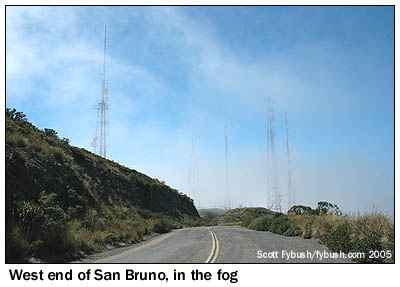
|
Over the next decade, KRON got company up here: KQED-TV (Channel 9), one of the nation's first educational stations, signed on here in 1954, and in 1958 independent KTVU (Channel 2) rounded out the San Francisco-Oakland VHF dial when it signed on from studios in Oakland and a transmitter up here.
At least two (and possibly three) UHF stations called San Bruno home in the early years, too: independent KEMO (Channel 20) and KBHK (Channel 44) both started out up here, and I suspect - though I'm not certain - that the short-lived KNEW-TV (Channel 32) also operated from San Bruno.
Early FM stations up here included NBC's KNBC-FM (99.7, later KNBR-FM) and Channel 4's sister station KRON-FM (96.5), both in 1949; KPEN-FM (101.3), KFRC-FM (106.1), KKHI-FM (95.7), KSFR (94.9) and KXKX (88.5) all joined the list in the late 1950s and early 1960s.
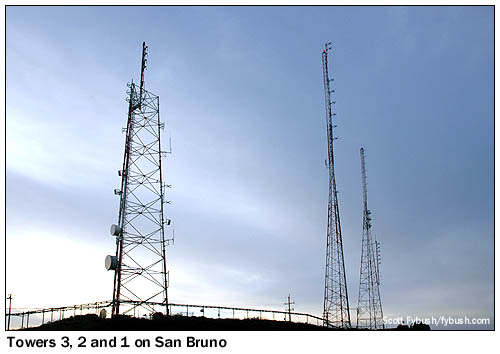 The
construction of Sutro Tower in the early 1970s (after the FAA
blocked proposals for a tall master tower on San Bruno) took
away many of this tower farm's tenants: channels 2, 4, 9, 20
and 44 all relocated to the new facility, as did KRON-FM on 96.5.
The
construction of Sutro Tower in the early 1970s (after the FAA
blocked proposals for a tall master tower on San Bruno) took
away many of this tower farm's tenants: channels 2, 4, 9, 20
and 44 all relocated to the new facility, as did KRON-FM on 96.5.
Their departure cleared the way for a new crop of UHF signals to appear up here: Chinese-language KTSF (Channel 26), religious KVOF (Channel 38), Spanish-language KDTV (originally on channel 60, then on 14) and public station KCSM-TV (originally on 14, then on 60) all came up here in the 1970s, with three more FMs (102.9, 105.3 and 107.7) also taking tower space on the hill.
In more recent decades, San Bruno has seen the TV lineup here change yet again, with KTSF going digital at its existing site, KVOF (now KCNS) and KCSM-TV moving to Sutro, KDTV moving to a site in the East Bay and two new signals moving up here (more on that in a bit). And one more FM, KRZZ (93.3), is here now, too, though its move from the East Bay hills came after our most recent visit in 2010.
That's the history: now, how about some tours?
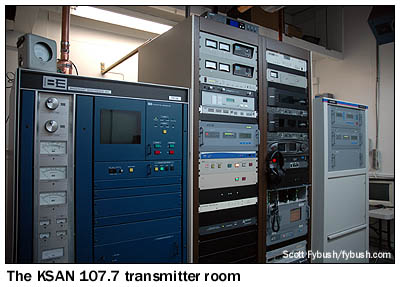 The
pictures you see here come from two separate visits to San Bruno:
one on an only-in-San-Francisco kind of day in 2005 when thick
fog blowing around the mountaintop was trying to give way to
bright sun, the other at dusk in January 2010.
The
pictures you see here come from two separate visits to San Bruno:
one on an only-in-San-Francisco kind of day in 2005 when thick
fog blowing around the mountaintop was trying to give way to
bright sun, the other at dusk in January 2010.
"Radio Road," the paved path up to the top of the ridge, is easily accessible to the public: it's part of San Bruno Mountain State Park, and you can pay your admission money at the gate and drive right up past all the towers - or, if you're lucky, you can bypass the gate and drive in with an engineer through their own special gate on the other side of the road.
The drive up Radio Road twists and turns a few times before it rounds a sharp bend that wraps around the hill where towers 1, 2 and 3 are perched. Tower 1 is the oldest surviving FM-only tower up here, built in 1960 for KPEN-FM (101.3) and KFRC-FM (106.1) and still used today by their successors, KIOI and KMEL.
Tower 2 went up in 1963 for KKHI-FM (95.7) and is still used by its successor station, now KGMZ; in 1966, it became the home of religious KXKX (88.5), which was sold a few years later and became public station KQED-FM. It's still there today, too.
The original Tower 3 went up in 1956 for KQED-TV (Channel 9); it was used briefly by KPEN before its move to Tower 1, and was also later used by KSFR (94.9, later KSAN). KQED-TV, of course, departed for Sutro in the early 1970s. In 1995, the original Tower 3 collapsed, and it was subsequently replaced by the fat tower that's now there, with 94.9 (now KYLD) mounted at the top.
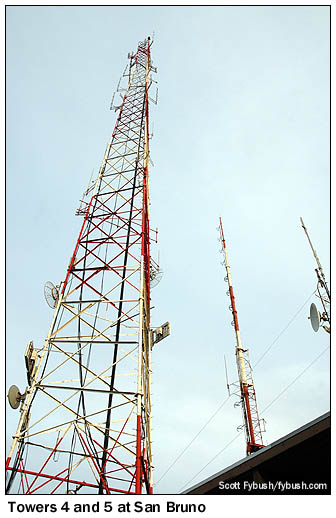 |
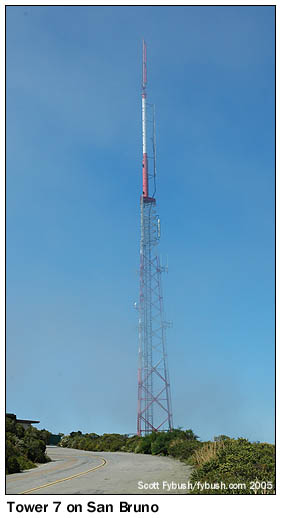 |
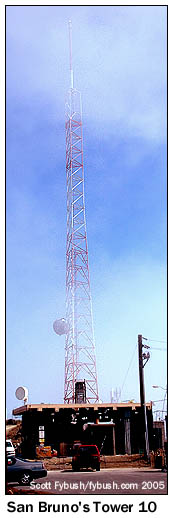
|
Towers 4 and 5 are across the road, perched on the edge of a steep drop-off facing northeast toward San Francisco. Tower 4 is a relatively new addition, built in 1980 when KBLX (102.9) moved to San Bruno from the old KRE plant in Berkeley that we showcased here a few weeks back. Tower 5 is the original KTVU (Channel 2) tower from 1958; after KTVU moved to Sutro, the tower became home to KITS (105.3) and what's now KSAN (107.7).
The KSAN transmitter room was the only one we got to see on our 2010 visit to the mountain. It's in one of many small rooms that form a warren of partitions and hallways in what used to be the KTVU transmitter building.
Continuing south and east on the twisty Radio Road, we next pass Tower 6 on the right. It went up in 1967 for the debut the following year of KEMO (Channel 20), which was part of the very short-lived Overmyer Network. Channel 20 survived the network's demise, but it didn't last long up here, moving to Sutro in the early 1970s. Tower 6 was used later on by 94.9, but today it's the only non-broadcast tower up here. (There is a defunct FM antenna near the top that I think is a former 94.9 antenna.)
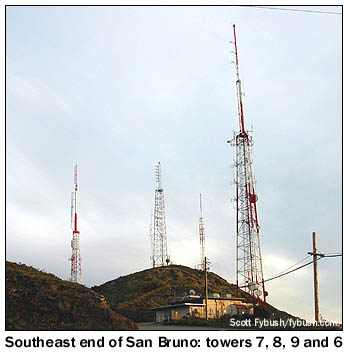
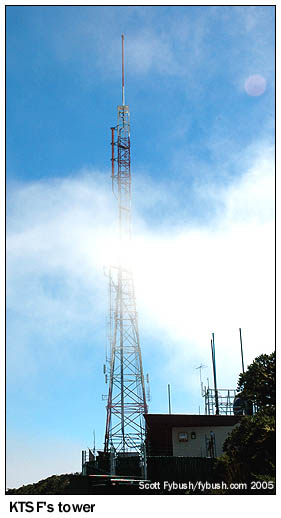 The current Tower
7, on the left as we drive to the end, is the newest tower here,
built in 2000 and now used by KKPX (RF 41/virtual 65), the San
Jose-licensed ion outlet that moved up here from Loma Prieta
Peak south of San Jose during the DTV conversion.
The current Tower
7, on the left as we drive to the end, is the newest tower here,
built in 2000 and now used by KKPX (RF 41/virtual 65), the San
Jose-licensed ion outlet that moved up here from Loma Prieta
Peak south of San Jose during the DTV conversion.
Towers 8 and 9 form a complex near the end of Radio Road on the right. This is the original KRON-TV/FM plant from 1949, and Tower 9 is the original KRON-TV/FM tower, now used by KTSF (RF 27/virtual 26) and by KRZZ 93.3). The original Tower 8 was a short tower for KNBC-FM, but NBC replaced it in 1968 with the much more substantial tower that carries 99.7's current incarnation, KMVQ-FM.
The road ends at a parking lot in front of Tower 10, built in 1968 for KBHK (Channel 44). After KBHK decamped for Sutro, this site became home to KDTV, and then also to KCSM-TV when KDTV swapped out its channel 60 allocation for KCSM's more desirable channel 14. KDTV eventually moved to the East Bay, and KCSM found itself displaced a few years ago after a big network affiliation shuffle shook up the market.
Unable to come to terms with the new owners of longtime affiliate KRON, NBC bought what had been a sleepy San Jose ABC affiliate, KNTV (Channel 11) and moved it as close as they could get it to San Francisco, which turned out to be up here at Tower 10. KNTV only operated analog channel 11 for a few years here, but it remains here on digital channel 12, one of just two VHF signals in the market. (Our photo of Tower 10 above shows the construction that was going on in 2005 as those moves were taking place.)
And with all that San Bruno excitement, we're stretching out our San Francisco tower pictures for one more week: join us again right here next week for a visit to Mount Sutro, and check in as well over at Tophour.com to hear lots and lots of San Francisco legal IDs!

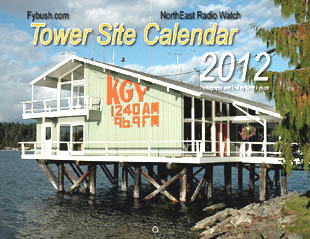 - Find out when the new Tower Site is posted,
and much more! Follow us on Twitter @NERadioWatch - and don't miss your very first chance to
order the new Tower Site Calendar 2012, now available at the
Fybush.com
store!
- Find out when the new Tower Site is posted,
and much more! Follow us on Twitter @NERadioWatch - and don't miss your very first chance to
order the new Tower Site Calendar 2012, now available at the
Fybush.com
store!- Previous Site of the Week: San Francisco, CA, 2010 (part III)
- Next Week: TBA
- Site of the Week INDEX!
- How can you help support Site of the Week? Click here!
- Submit your suggestions for a future Site of the Week!
